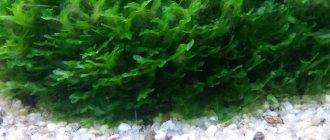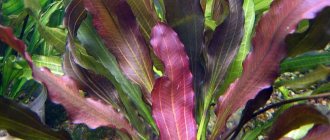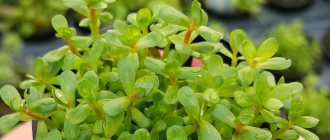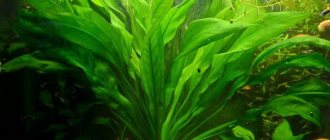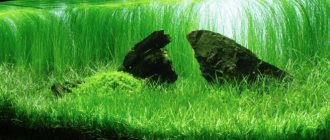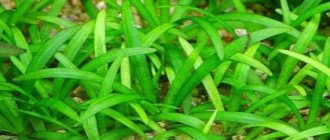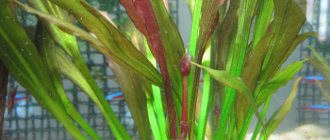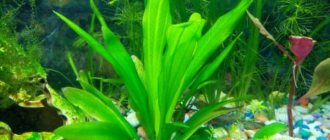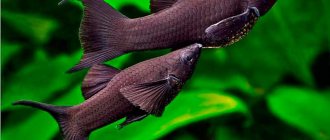Green uniform
The peculiarity of the green subtype is spotted leaves in the shape of a narrow ellipse.
Young plants have brownish-red patches on the green leaf blades. In mature bushes, the shade changes to dark olive, but the spotted pattern remains.
Plants can exist in both above-water and underwater forms. In the first case, small white flowers sometimes appear on the bush.
Underwater specimens are distinguished by wider and wavy leaves.
Red uniform
Ocelot Red is a plant with wavy, ovate leaves. The color of the plates is pink, red, light brown, golden. There are dark red spots along the entire perimeter of the leaves. In younger specimens they have a pronounced elliptical shape.
Conventionally, another subtype is distinguished by color - green-flaming. The shade of the leaves smoothly flows from green to red, so it is difficult to determine the background color.
Echinodorus 'Ozelot' is an ornamental hybrid between Echinodorus schluteri 'Leopard' and Echinodorus 'Barthii'. As an adult, its dimensions are 20-50 cm high and 20-40 cm wide. In the aquarium hobby, two of its varieties are known with red and dark olive-colored spots on the leaves. It was the elliptical dark spots, reminiscent of the coloring of the skin of a spotted cat, that gave this plant the name “Ocelot”. The darkest and most contrasting spots appear on the youngest leaves, but unlike many other spotted Echinodorus, 'Ocelot' retains its mottled appearance even in low light intensity. This is a fairly undemanding plant, suitable for beginners.
Echinodorus Ocelot green
The dark olive spots of the green ocelot form a very beautiful contrast with its bright leaves. Echinodorus Ocelot green is an interesting spotted hybrid form that adapts well to a variety of aquarium conditions. This majestic plant creates beautiful contrasts with other aquarium plants and does not require special care. This hybrid appeared on the market only in 1998, it comes from the nursery of Hans Barth.
Keeping a green ocelot
A nutrient substrate or fertilizing with fertilizer beads promotes the full growth of this large Echinodorus. In general it is a very popular aquarium plant, but due to its size (up to 40 cm high and 30 cm wide) it is only suitable for large aquariums. They can be kept even in unheated home aquariums, as well as in tropical temperatures; water hardness and water also do not make much difference to their healthy growth. Green Echinodorus Ocelot can survive in shady areas of the aquarium, but when exposed to direct light, the dark spots on the light green leaves appear more pronounced. Fine-grained soil, rich in nutrients, is a necessary maintenance condition and promotes the development of shoots of rhizomes, with which the ocelot reproduces.
In addition to the spotted leaves, their wavy edges give special interest to aquadesign. If this plant is placed in the background of the aquarium, it will make a worthy impression. It will be enhanced by contrasting long stems (such as pogostemon, bacopa and cabomba) and mosses on the sides and ground cover (hemianthus cubes, lileopsis) in the foreground. Vallisneria located at some distance makes the composition more loose, red-leaved plants (Lagenandra red, Alternanthera rhineca mini, Bucephalandra) create beautiful contrasts.
At high light intensity and in densely planted boosted aquariums, herbalists need a CO2 supply. Since there are no other special care requirements, even beginners can handle Echinodorus 'Ocelot' green.
Green ocelot breeding
In an open aquarium, the inflorescences often form above the water. Daughter plants sometimes develop directly on the flowers. Like rhizome shoots from the rhizome, they can be replanted after separation. In older, stronger specimens, division of the rhizome is also possible. Young plants acquire the typical spotted leaf color after a short time.
Echinodorus Ocelot red
Echinodorus 'Red Flame' - a red-spotted variety of Echinodorus 'Ocelot' - is a relatively unpretentious plant popular in the aquarium hobby because of its pronounced red-brown coloring of the spots on the leaves. In above-water culture, when grown in a paludarium, these plants do not look as attractive. But once the red ocelot is transplanted into the aquarium, its true potential quickly becomes apparent as new leaves grow.
The red Echinodorus ocelot 'Red Flame' resembles the original plant in its basic properties. New leaves have a lovely red-brown or green base color with dark red spots. As it matures, its leaves become more reddish, but remain spotted. Young leaves have spots of a more intense red color, which contrasts more strongly with the main color, while the color of the spots on older leaves becomes more and more rich, brown-brown. The more light, the brighter and more contrasting the colors of the red ocelot. The leaves of Echinodorus 'Red Flame' are oval and slightly wavy, which together with their color can actually give the appearance of moving flames in the water. Do not confuse it with the “small bear”. Under water, they reach a length of 10-30+ cm and a width of 3-5 cm. With a total height of 40 cm, the red ocelot is only suitable for large aquariums.
Ocelot breeding ed.
In open tanks under good conditions, flower stalks up to 1 m long can appear from the water, on the inflorescences of which daughter plants develop. If they are lightly pressed to the ground, this promotes the formation of roots, and the shoots can be used for propagation. Reproduction also occurs through lateral shoots formed from the roots.
Keeping the Red Ocelot The Red Ocelot needs nutrient-rich soil and plenty of light for healthy growth and display of vibrant leaf colors. Care should also be taken to ensure an adequate CO2 supply. The ideal water temperature is 20-28 ° C, water hardness is 1-15 ° KH. The pH value can be in the range of 5.5-7.5.
Video: Echinodorus ocelot green and red
Care and disembarkation
To plant a plant in an aquarium, you need to pull it out of the soil and clear the roots of small shoots. After this, you need to carefully place the bush in the substrate and transfer it to a container intended for the permanent residence of Echinodorus.
If you want to place several specimens in the aquarium, when planting, you should leave as much space between them as possible. The root system of the plant is developed, so it is better to plant the bush deeper into the ground.
Plants do not require specific care. It is enough to replace 1/5 of the water, aerate and filter once a month.
Water parameters
Echinodorus can survive even in hard water.
The optimal value is 5-15 dKH with neutral acidity. The plant tolerates periodic temperature fluctuations without problems, but feels best at 20-26°C.
Lighting
The ocelot feels good in any light, but the ideal option is light from 60 Lm/l for at least 8 hours a day.
The bush may be in the shade for some time. During this period, it will not lose its brightness of color, but will grow more slowly.
Provided there is sufficient light, the plant produces new leaves every week.
Soil, nutrient substrate
River sand with coarse fractions is best suited as a soil. Possible options: granite or quartz chips, small pebbles. The optimal soil layer is at least 8 cm.
There are no strict requirements for the nutritional support. You can use a moderate substrate or root tablets.
Fertilizer requirements
- Echinodorus Ocelot does not require any fertilizer. But to improve growth, it is recommended to use balls containing micro and macro substances.
- Liquid fertilizers have a good effect. The addition of CO2 in any form will also have a positive effect on the plant’s habit.
Content
Water parameters
The importance of hygrophila is that it perfectly cleans and filters aquarium water from nitrates, and it is comfortable for fish to spawn on its leaves.
It is unpretentious and very quickly turns into dense thickets that serve as a home for fry, shrimp and snails. The plant thrives in a wide range of temperatures, which does not in any way affect its growth and reproduction.
To ensure that the roots and lower tiers have enough light, the upper leaves must be periodically trimmed. Otherwise, the bottom will begin to die and the plant will wither.
Since hygrophila grows in its natural habitat in the tropics, the optimal temperature for its growth and development is 20-28 degrees. It easily tolerates warmer water, but a decrease in temperature can negatively affect the delicate plant. You should also maintain water hardness within 3-15 dH, and acidity between 6 and 7 pH. Failure to meet these parameters will cause the leaves to become thin, acquire a yellow tint, and holes will begin to appear in them. Ultimately, the plant will rot and die. Hygrophila loves water changes, so it is advisable to regularly replace 25% of the total volume.
Lighting
As for lighting, hygrophila loves a lot of light. However, direct sunlight can cause burns on delicate leaves. This is also fraught with the growth of harmful algae like “blackbeard”. They completely cover the plant, taking in all the light, which inevitably kills the hygrophila.
To prevent this, it is necessary to select fluorescent lighting of medium and low power, within 0.5 W per liter. If there is insufficient lighting, the plant will slow down, the trunks will begin to thin, and the leaves will decrease in size. It is recommended to turn on the lamps for 10-12 hours every day to provide the hygrophile with comfortable conditions. A healthy plant with sufficient light will have large leaves with brownish or reddish veins.
As mentioned above, hygrophila is an excellent filter for an aquarium. It is completely unpretentious to regular cleaning. In an aquarium with it, you can install low- and medium-power filters, which will work in the corner opposite from the plant, releasing a stream of water in its direction.
Reproduction
Plant propagation occurs vegetatively. An arrow appears on the mother bush, on which shoots are formed.
To get a separate individual, you need to carefully separate the “babies” and plant them in the soil. In order to control the spread of the plant, daughter shoots can be removed.
Advice for beginners from experienced aquarists
- You should not make drastic changes to the aquarium. Unstable parameters of water hardness, lighting and temperature can lead to plant rotting over time.
- The bush gets along well with other varieties of aquatic flora and fish. The plant has rather hard leaves, so other inhabitants of the aquarium will not be able to damage them.
- It is better to plant Echinodorus Ocelot in a large aquarium, since the bush grows quite large in length and width. If the container is too small, the plant will take up all the space. The ideal aquarium volume is from 100 liters.
- When algae appears on underwater leaves, it is necessary to carefully clean off the plaque.
Description
This animal was discovered quite recently. This is explained by the fact that in nature it lives only in the state of Burma, namely in local small ponds. In addition to it, other species of fish were found, but due to its appearance, it was the microscopic galaxy that became especially interesting to both scientists and aquarists.
This creature has raised many questions among naturalists. At first it was assigned to the genus Rasbora, but in 2007 a scientific work was published, which indicated that this fish still has more similarities with zebrafish.
This animal is naturally found in high mountain rivers, ponds and lakes, with dense vegetation. These are mainly reservoirs fed by spring floods. They are open to the sun, which is why plants and algae actively develop in them. These fish mainly live in shallow streams with a depth of only 30 cm, but the water there is very clean, and Elodea and Blixa are found among the flora.
Males have a blue-gray body with many small pearl-colored spots. The fins have red and black stripes, and the belly is a rich red color. Females don't look as impressive. They have faded spots and fins.
It is quite easy to distinguish a female from a male. Males have a brighter color and a red belly.
Individuals grow very small, no more than 2 cm, so this is an ideal option if you want to start a nano aquarium or shrimp tank. Life expectancy is about 2 years.
